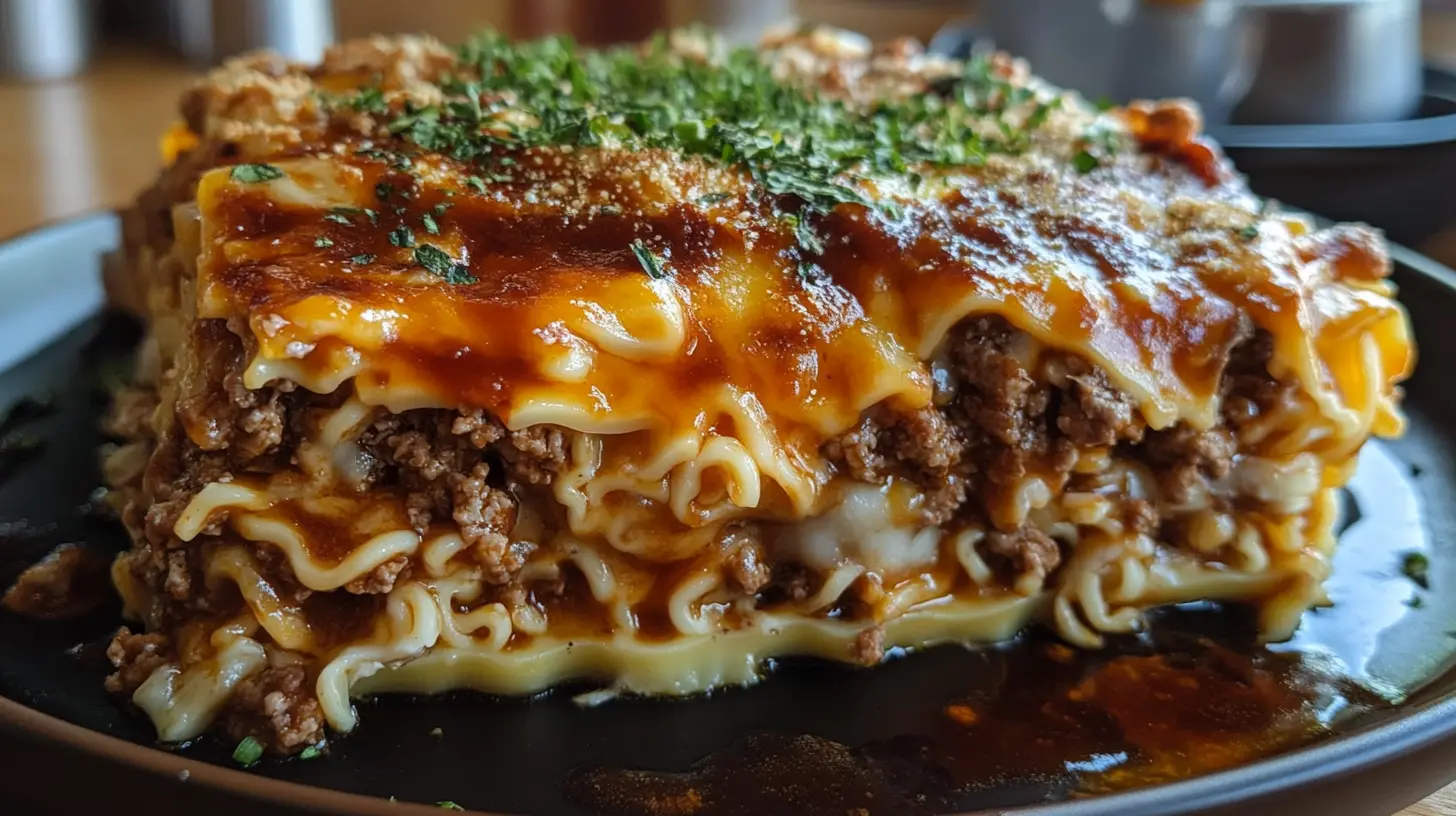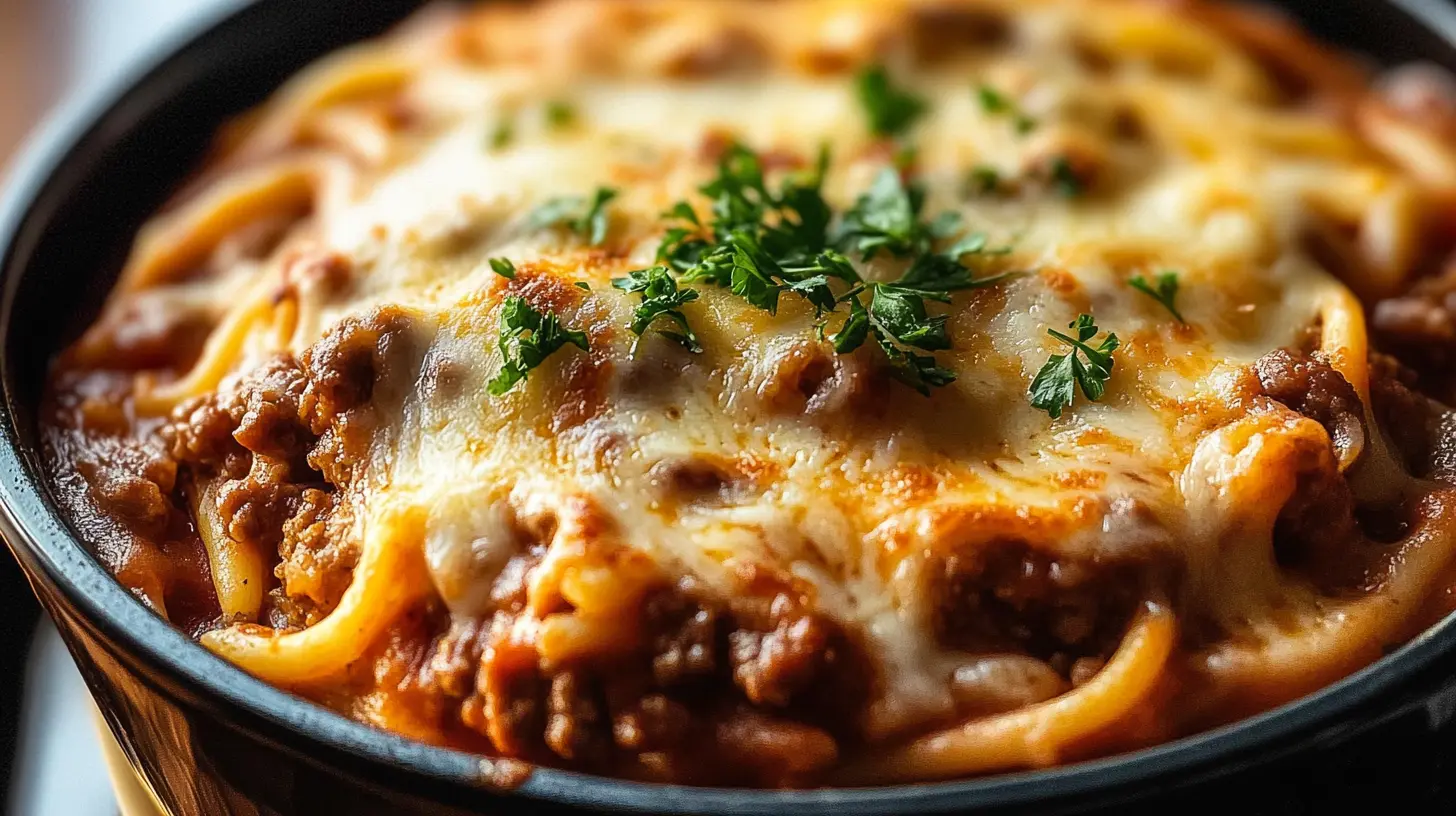Introduction to Ramen Lasagna
If you are looking for a unique twist on traditional lasagna, then you should try Ramen Lasagna! This innovative dish combines the rich, comforting layers of classic lasagna with the delightful texture of ramen noodles. Perfect for home cooks and food enthusiasts alike, this recipe offers a delicious alternative to regular pasta dishes. Whether you’re a busy parent seeking a quick dinner option or a food enthusiast eager to explore new culinary trends, Ramen Lasagna will surely delight your taste buds and become a favorite in your kitchen. Plus, this dish is incredibly versatile, allowing you to adapt it to different dietary needs and preferences.
To add a creative twist to your weekly meal plan, you might also want to explore our Cheesy Hot Beef Sandwich Recipe for another comfort food classic.
Benefits and Advantages of Ramen Lasagna
Ramen Lasagna offers several benefits that make it a standout choice for any meal:
- Ease of Preparation: Unlike traditional lasagna, which often requires pre-cooking the pasta, Ramen Lasagna uses instant ramen noodles that cook quickly and absorb the flavors of the sauce, making preparation much simpler and faster.
- Health Benefits: By incorporating fresh vegetables and lean meats, you can make this dish both delicious and nutritious. You can also choose low-sodium ramen noodles and homemade sauces to control the ingredients and reduce unhealthy additives.
- Adaptability: This recipe is highly adaptable. You can easily make a vegetarian version by substituting the meat with tofu or a variety of vegetables. For a vegan twist, use plant-based cheese and a rich vegetable-based sauce.
If you’re interested in other unique pasta dishes, you might want to check out our Lasagna Pasta Recipe for another fun take on a classic favorite.
Ingredients Overview
Essential Ingredients for Ramen Lasagna
To make the perfect Ramen Lasagna, you’ll need the following ingredients:
- Ramen Noodles: 3-4 packs of instant ramen noodles (use any flavor, but discard the seasoning packets).
- Ground Beef or Turkey: 1 pound, or use a plant-based alternative for a vegetarian option.
- Marinara Sauce: 2 cups of your favorite brand or homemade.
- Ricotta Cheese: 1 cup, or substitute with cottage cheese for a lighter option.
- Mozzarella Cheese: 2 cups, shredded.
- Parmesan Cheese: 1/2 cup, grated.
- Fresh Vegetables: Spinach, bell peppers, onions, and mushrooms are excellent choices.
- Olive Oil: 1 tablespoon for sautéing.
- Garlic: 2 cloves, minced.
- Italian Seasoning: 1 tablespoon, or a mix of oregano, basil, and thyme.
- Salt and Pepper: To taste.
For more inspiration, you can explore our Sourdough Sandwich Bread Recipe which offers tips on incorporating different flavors and textures into your dishes.
Dietary Substitutions to Customize Your Ramen Lasagna
- Gluten-Free: Use gluten-free ramen noodles or rice noodles as a substitute.
- Low-Calorie: Opt for low-fat cheeses and increase the amount of vegetables to reduce calories while maintaining flavor.
- Vegan: Use vegan cheese and a tofu-based ricotta alternative to make this dish entirely plant-based.
By making these simple substitutions, you can create a ramen lasagna that aligns perfectly with your dietary needs.
How to Prepare the Perfect Ramen Lasagna: Step-by-Step Guide
First Step: Prepare the Ingredients
- Cook the Ground Meat: In a large skillet, heat olive oil over medium heat. Add the ground beef or turkey and cook until browned. Add minced garlic and cook for another minute. Drain any excess fat.
- Add the Sauce: Stir in the marinara sauce and Italian seasoning. Let the mixture simmer for 5 minutes. Season with salt and pepper to taste.
Second Step: Layer the Lasagna
- Prepare the Baking Dish: Preheat your oven to 375°F (190°C). Grease a baking dish with olive oil.
- Layer the Ingredients: Start with a layer of the meat sauce at the bottom of the dish. Top with a layer of ramen noodles, breaking them up as needed to fit. Spread a layer of ricotta cheese over the noodles, followed by a layer of vegetables. Repeat until all ingredients are used, ending with a layer of mozzarella and Parmesan cheese on top.
Third Step: Bake and Serve
- Bake the Lasagna: Cover the dish with aluminum foil and bake for 20 minutes. Remove the foil and bake for an additional 10-15 minutes, or until the cheese is bubbly and golden.
- Let It Rest: Allow the lasagna to rest for 10 minutes before slicing. This helps the layers set and makes serving easier.
Enjoy your delicious and unique Ramen Lasagna! For more creative recipes, check out our Ninja Creami Recipes for a fun way to make frozen treats at home.
Mastering Ramen Lasagna: Advanced Tips and Variations
To elevate your ramen lasagna game, consider these advanced tips:
- Add a Bechamel Sauce: For a richer flavor, layer a homemade bechamel sauce between the noodles and meat sauce.
- Incorporate Different Cheeses: Use a blend of cheeses like provolone, asiago, and gouda for a more complex flavor profile.
- Experiment with Ramen Flavors: Try different ramen flavors, like spicy chicken or shrimp, to add a unique twist to your lasagna.
How to Store Ramen Lasagna: Best Practices
- Refrigeration: Store leftovers in an airtight container in the refrigerator for up to 3 days.
- Freezing: You can freeze lasagna portions for up to 3 months. To reheat, thaw in the refrigerator overnight and bake at 350°F (175°C) for 20 minutes.
Nutritional Value of Ramen Lasagna
A serving of ramen lasagna provides approximately:
- Calories: 450
- Protein: 25g
- Carbohydrates: 40g
- Fat: 20g
FAQs: Frequently Asked Questions About Ramen Lasagna
Is 2 layers of noodles enough for lasagna?
Two layers can be enough, but for a more substantial lasagna, three or more layers are ideal. This ensures each bite has a balance of noodles, sauce, and fillings.
How to make pasta for ramen?
To make ramen-style noodles, mix flour, water, salt, and baking soda into a dough. Roll it thin and cut into strips. Cook in boiling water for a few minutes until tender.
Can you eat undercooked lasagne sheets?
Eating undercooked lasagna sheets is not recommended due to potential digestive discomfort. Always ensure lasagna sheets are fully cooked before serving.
What is a 100-layer lasagna?
A 100-layer lasagna is a specialty dish that features a hundred thin layers of pasta, sauce, and fillings. It’s more of a showstopper for special occasions than an everyday meal.
Are no-boil lasagna noodles better?
No-boil lasagna noodles are convenient, but they require adequate sauce to cook properly in the oven. They can save time and reduce the need for pre-cooking.
For a deeper dive into lasagna variations and history, visit the Wikipedia page on Lasagna.
Is 2 layers of noodles enough for lasagna?
Two layers of noodles can be sufficient for lasagna, especially if you’re preparing a smaller, more compact version. However, traditional lasagna usually consists of at least three layers to ensure a balanced structure of noodles, sauce, cheese, and fillings. Furthermore, three or more layers provide better distribution of flavors and textures in every bite, thereby enhancing the overall eating experience. Although a two-layer lasagna might lack the depth and richness of a more layered version, it is still a practical option for a quick and simple meal.
How to make pasta for ramen?
To make pasta for ramen from scratch, follow these steps:
Ingredients:
- 2 cups of all-purpose flour
- 1/2 teaspoon of salt
- 1/2 teaspoon of baking soda (to mimic the alkaline properties of traditional ramen noodles)
- 2 large eggs
- Water, as needed
Method:
- Mix the Dry Ingredients: First, combine the flour, salt, and baking soda in a large bowl.
- Add the Eggs: Next, create a well in the center of the flour mixture, crack the eggs into it, and mix until a dough forms. If the dough is too dry, add water gradually.
- Knead the Dough: Then, knead the dough on a floured surface for about 5-10 minutes until it becomes smooth and elastic.
- Rest the Dough: After that, wrap the dough in plastic wrap and let it rest for at least 30 minutes to relax the gluten.
- Roll and Cut the Dough: Once rested, roll out the dough to your desired thickness and cut it into thin strips resembling ramen noodles.
- Cook the Noodles: Finally, boil the noodles in salted water for 2-3 minutes until al dente. Drain and rinse with cold water to stop the cooking process and set the texture.
How to stop lasagna from falling apart?
To prevent lasagna from falling apart:
- Let It Rest: After baking, you should allow the lasagna to rest for at least 10-15 minutes. This resting period helps the layers set, making it easier to cut clean slices.
- Proper Layering: Ensure that each layer of noodles is adequately covered with sauce. This helps the layers stick together and creates a cohesive structure.
- Avoid Overcooking Noodles: Moreover, cook noodles al dente or use no-boil noodles that soften during baking. Overcooked noodles can become too soft and may not hold up well.
- Use Enough Cheese and Sauce: Additionally, the cheese and sauce act as binding agents. Make sure there’s enough of each to help hold the layers together without making the lasagna too watery.
How to make ramen noodles on the stove?
To make ramen noodles on the stove:
- Boil Water: First, bring a pot of water to a boil (about 2 cups per package of ramen).
- Add Noodles: Then, drop the ramen noodles into the boiling water. Gently stir to separate the strands.
- Cook the Noodles: Next, boil the noodles for 2-3 minutes until they reach your desired texture.
- Add Seasoning: If you are using the seasoning packet that comes with the ramen, add it to the pot and stir until fully dissolved.
- Serve: Once the noodles are cooked, transfer them to a bowl along with the broth. You can also add toppings like sliced green onions, boiled eggs, or vegetables for added flavor.
Do you boil lasagna noodles before layering?
Traditionally, lasagna noodles are boiled before layering them in the dish. Boiling the noodles ensures they are tender and will cook evenly in the oven. However, many modern recipes use no-boil lasagna noodles, which do not require pre-cooking. These no-boil noodles are designed to absorb moisture from the sauce during baking, thereby softening them in the oven. If using traditional noodles, boiling them first is crucial to avoid a chewy texture.
What is 100 layer lasagna?
A 100-layer lasagna is an elaborate version of the classic dish that features many thin layers of pasta, sauce, cheese, and sometimes other fillings. This style of lasagna is typically a showcase dish at high-end restaurants or for special events. The 100 layers are achieved by using very thin sheets of pasta and carefully layering them with minimal amounts of filling to create a tall, structured lasagna. Consequently, this dish is visually impressive and provides a unique texture experience due to the numerous thin layers.
Is there a wrong way to layer lasagna?
While there isn’t a strictly “wrong” way to layer lasagna, certain methods yield better results:
- Start with Sauce: First, begin with a layer of sauce on the bottom of the baking dish to prevent sticking.
- Alternate Layers Properly: Then, follow a consistent pattern of noodles, sauce, cheese, and fillings to ensure even cooking and flavor distribution.
- Finish with Cheese: Next, top the lasagna with a layer of cheese to achieve a golden, bubbly finish.
- Avoid Overloading Layers: Finally, avoid overloading layers with too much filling or sauce, as this can make the lasagna messy and difficult to serve.
Why is my lasagna always dry?
Lasagna can turn out dry for several reasons:
- Not Enough Sauce: First of all, insufficient sauce can lead to dry noodles. Make sure each layer is adequately covered with sauce.
- Overbaking: Moreover, baking lasagna for too long or at a high temperature can cause it to dry out. Stick to the recommended baking time and temperature.
- Using Low-Moisture Ingredients: Ingredients like pre-shredded cheese can contain anti-caking agents that absorb moisture. Instead, freshly grated cheese and juicy vegetables can help add moisture to the dish.
Why is my lasagne always sloppy?
A sloppy lasagna may result from:
- Excess Liquid in the Sauce: If the sauce is too watery, it can make the lasagna sloppy. Therefore, ensure your sauce is thickened before layering.
- Not Enough Noodles: Using too few noodles can lead to instability, making the lasagna hard to serve cleanly.
- Improper Resting Time: Not allowing the lasagna to rest after baking can cause the layers to shift and result in a sloppy dish.
Can I soak lasagna noodles instead of boiling?
Yes, soaking lasagna noodles instead of boiling is an alternative method. Place the dry noodles in a large baking dish and cover them with hot water. Let them soak for about 20-30 minutes until they are pliable but not fully cooked. This technique softens the noodles enough to cook through during baking without becoming mushy. Soaking is a convenient method that saves time and reduces the chance of overcooking.
What happens if you don’t boil lasagna noodles?
If you don’t boil traditional lasagna noodles before layering, they might remain hard or undercooked, resulting in a chewy texture. However, using plenty of sauce can help soften the noodles during baking. Alternatively, no-boil lasagna noodles are specifically designed to cook through during baking without pre-boiling, making them a convenient choice.
Are no-boil lasagna noodles better?
No-boil lasagna noodles offer several benefits:
- Convenience: They save time and eliminate the need for boiling, making the preparation process easier.
- Uniform Cooking: Additionally, no-boil noodles are designed to cook evenly in the oven, reducing the risk of undercooked pasta.
- Texture: These noodles tend to be thinner, which can create a more delicate texture in the finished dish. However, some people prefer the thicker texture of traditional noodles.
Conclusion
Ramen Lasagna is a delightful fusion that combines the best of two beloved dishes. Easy to prepare and customize, it suits a variety of dietary preferences and is perfect for any occasion. Whether you’re a fan of traditional lasagna or looking to try something new, this recipe will not disappoint. Enjoy exploring the creative possibilities of ramen lasagna and share it with your loved ones!

Posted by: Hailee | November 5, 2024
I’m passionate about sharing sweet and savory recipes that I’ve meticulously tested and perfected in my own kitchen. Join me on this delicious journey to experience the best of culinary creativity.




